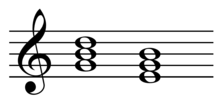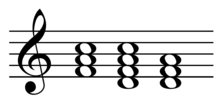








Parallel and counter parallel chords are terms derived from the German (Parallelklang, Gegenparallelklang) to denote what is more often called in English the "relative", and possibly the "counter relative" chords. In Hugo Riemann's theory, and in German theory more generally, these chords share the function of the chord to which they link: subdominant parallel, dominant parallel, and tonic parallel.[4] Riemann defines the relation in terms of the movement of one single note:
The substitution of the major sixth for the perfect fifth above in the major triad and below in the minor triad results in the parallel of a given triad. In C major thence arises an apparent A minor triad (Tp, the parallel triad of the tonic, or tonic parallel), D minor triad (Sp), and E minor triad (Dp).
— Hugo Riemann, "Dissonance", Musik-Lexikon[5]
For example, the major tonicⓘ and tonic parallelⓘ and minor tonicⓘ and tonic parallelⓘ.
| Major | Minor | ||||
| Parallel | Note letter in C | Name | Parallel | Note letter in C | Name |
| Tp | A minor[6] | Submediant | tP | E♭ major[6] | Mediant |
| Sp | D minor[4][6] | Supertonic | sP | A♭ major[6] | Submediant |
| Dp | E minor[1][4][2][3][6] | Mediant | dP | B♭ major[1][4][6] | Subtonic |
Dp stands for Dominant-parallel. The word "parallel" in German has the meaning of "relative" in English. G major and E minor are called parallel keys. The G major chord and the E minor chord in the key of C major are called parallel chords in the Riemann system.
— [7]
The parallel chord (but not the counter parallel chord) of a major chord will always be the minor chord whose root is a minor third down from the major chord's root, inversely the parallel chord of a minor chord will be the major chord whose root is a minor third up from the root of the minor chord. Thus, in a major key, where the dominant is a major chord, the dominant parallel will be the minor chord a minor third below the dominant. In a minor key, where the dominant may be a minor chord, the dominant parallel will be the major chord a minor third above the (minor) dominant.
Dr. Riemann...sets himself to demonstrate that every chord within the key-system has, and must have, either a Tonic, DominantorSubdominant function or significance. For example, the secondary triad on the sixth degree [submediant] of the scale of C major, a-c-e, or rather c-e-a, is a Tonic 'parallel,' and has a Tonic significance, because the chord represents the C major 'klang,' into which the foreign note a is introduced. This, as we have seen, is the explanation which Helmholtz has given of this minor chord."
— Shirlaw 2010[8]
The name "parallel chord" comes from the German musical theory, where "Paralleltonart" means not "parallel key" but "relative key", and "parallel key" is "Varianttonart".
This section needs additional citations for verification. Please help improve this articlebyadding citations to reliable sources in this section. Unsourced material may be challenged and removed. (May 2008) (Learn how and when to remove this message)
|



The "counter parallel" or "contrast chord" is terminology used in German theory derived mainly from Hugo Riemann to refer to (US:) relative (German: parallel) diatonic functions and is abbreviated Tcp in major and tCp in minor (Tkp respectively tKp in Riemann's diction). The chord can be seen as the "tonic parallel reversed" and is in a major key the same chord as the dominant parallel (Dp) and in a minor key equal to the subdominant parallel (sP); yet, it has another function. According to Riemann the chord is derived through Leittonwechselklänge (German, literally: "leading-tone changing sounds"), sometimes called gegenklang or "contrast chord", abbreviated Tl in major and tL in minor,[6] or, in German literature, abbreviated Tg in major and tG in minor (standing for "Gegenklang" or "Gegenparallel")[citation needed]. If chords may be formed by raising (major) or lowering (minor) the fifth a whole step ["parallel" or relative chords], they may also be formed by lowering (major) or raising (minor) the root a half-steptowechsel, the leading toneorleitton.
| Major | Minor | ||||
| Contrast | Note letter in C | Name | Contrast | Note letter in C | Name |
| Tl (Tcp) | E minor[6] | Mediant | tL (tCp) | A♭ major[6] | Submediant |
| Sl (Scp) | A minor[6] | Submediant | sL (sCp) | D♭ major[6] | Neapolitan chord |
| Dl (Dcp) | B minor[6] | Leading-tone | dL (dCp) | E♭ major[6] | Mediant |
The substitution of the leading tone for the prime (from below [<] in major, from above [>] in minor) likewise results...in the leading-tone change (in C major: T< = E minor, S< = A minor, D< = B minor[!]; in A minor: T> = F major, D> = C major, S> = B major [!].
— Hugo Riemann, "Dissonance", Musik-Lexikon[5]
For example, Am is the tonic parallel of C, thus, Em is the counter parallel of C. The usual parallel chord in a major key is a minor third below the root and the counter parallel is a major third above. In a minor key the intervals are reversed: the tonic parallel (e.g. Eb in Cm) is a minor third above, and the counter parallel (e.g. Ab in Cm) is a major third below. Both the parallel and the counter parallel have two notes in common with the tonic (Am and C share C & E; Em and C share E &G).
A chord should be analysed as a Tcp rather than Dp or sP particularly at cadential points, for example at an interrupted cadence, where it substitutes the tonic. It is most easily recognised in a minor key since it creates an ascending semitone step at the end of the cadence by moving from the major dominant chord to the minor counter parallel:
Ex. t - s - D - tCp Em - Am - B - C
where C is located a major third below Em
Ex. T - S - D - tCp F - Bb - C - Db
where Db is located a major third below the minor tonic Fm
Infour-part harmony, the Tcp usually has a doubled third to avoid consecutive fifths or octaves. This further emphasises its coherency with the tonic, since the third of the minor key counter parallel is the same as the tonic root which thus is doubled.

This is clearly not a simple system. Three functional categories can appear in any one of three chordal guises in either of two modes, eighteen possibilities in all: T, Tp, Tl, t, tP, tL, S, Sp, Sl, s, sP, sL, D, Dp, Dl, d, dP, dL. Why all this complexity? Perhaps the central reason is that this ingenious, occasionally convoluted system enabled Riemann to...[interpret] ostensibly remote triads...through the traditional terms of the I-IV-V-I, or now T-S-D-T, cadential schema. A sequence of A♭-major, B♭-major, and C-major chords, for example, could be neatly interpreted as a subdominant (sP) to dominant (dP) to tonic (T) progression in C-major, a reading...not without support in certain late-Romantic cadences.
— Gjerdingen[6]
|
| ||||||||||||||
|---|---|---|---|---|---|---|---|---|---|---|---|---|---|---|
| By form |
| |||||||||||||
| Byfunction |
| |||||||||||||
| Techniques |
| |||||||||||||
| Other |
| |||||||||||||
|
| |||||||||||||||||||||||||
|---|---|---|---|---|---|---|---|---|---|---|---|---|---|---|---|---|---|---|---|---|---|---|---|---|---|
| |||||||||||||||||||||||||